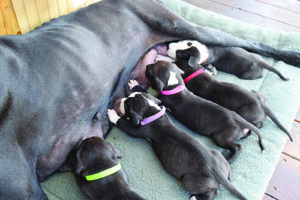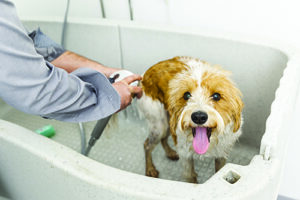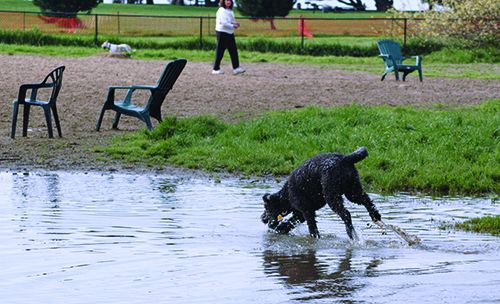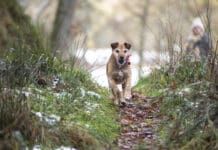Diarrhea isn’t fun for anybody. When your dog gets it – and feeding boiled chicken or hamburger with rice doesn’t make it go away – it’s time to see your veterinarian. There are lots of different causes of dog diarrhea, including dietary indiscretion (also known as eating dumb stuff), viruses, stress, abrupt diet changes, food allergy, inflammatory bowel disease, and of course, intestinal parasites. Of the intestinal parasites, some are worms and some are protozoans.
Protozoans are single-cell microscopic organisms. These organisms are free-living in the environment. When they get inside a host and cause disease, they are considered parasites.
In dogs, the two most common protozoan parasites we see are Coccidia and Giardia. These parasites cause disease in the intestinal tracts of dogs, resulting in diarrhea. Both are contagious and hard to eliminate from the environment. Dog owners should be aware of these diseases, how their dogs may become infected, and what to do about it.
Coccidia in Dogs
There are many different species of Coccidia, also known as Isospora, but only four that infect dogs. Isospora protozoans are species-specific, which means the ones that infect dogs infect only dogs, the ones that infect poultry infect only poultry, and so on. As such, coccidiosis (an infection with Coccidia) in dogs is not a zoonotic disease, which means there is no need to worry about yourself or your family becoming infected, should your dog become infected. And your dog is not going to get infected by being around other species of animals.
How do dogs get Coccidia?
How is it spread? Infected dogs pass oocysts in their stool. Interestingly, these oocysts are not infectious until they spend some time in favorable environmental conditions (temperatures of 70° to 100° F and high humidity) and go through a process called sporulation. Sporulation can occur within hours of the oocysts being passed, and ingesting sporulated oocysts is how your dog becomes infected.
Ingestion doesn’t mean your dog has to eat poop. It can happen when a dog sniffs poop or a poop-contaminated area and then licks his nose! Walking through infected areas and later licking their paws, swallowing flies or other insects that have ingested sporulated oocysts, and eating infected mice are all ways your dog could pick up Coccidia.
Symptoms of Coccidia in Dogs

The most common sign in clinically affected dogs is diarrhea. For some dogs, the parasitic infection is self-limiting, and may not require treatment. These are the ones that get better with the hamburger and rice. For most dogs, however, treatment is required to resolve the diarrhea and eliminate the infection.
Young puppies and stressed, debilitated, or immune-compromised dogs are usually the ones most severely affected. Some dogs with coccidiosis are asymptomatic (don’t show any signs of illness). This is a good reason to have stool samples checked regularly on your dog, so if a Coccidia infection is identified it can be treated before it gets worse. Treatment of oocyst-shedding, asymptomatic dogs also helps minimize environmental contamination and spread of the parasite.
Coccidia Diagnosis
Coccidiosis is diagnosed by a test done on a stool sample called a zinc sulfate fecal floatation with centrifugation, which identifies the oocysts. It’s usually pretty easy to diagnose. There is a chance, however, that symptoms may occur before oocysts are actively being shed. So, if your dog with diarrhea has a negative test, but continues having diarrhea, be sure to submit a second sample for analysis.
Coccidia Treatment
Treatment for coccidiosis in a veterinary clinic setting is typically a prescription medication called sulfadimethoxine (Albon, Zoetis). This medication is “coccidiostatic” – this means it doesn’t kill the protozoa, it just prevents their reproduction, thereby slowing the infection down and giving the dog’s immune system a better chance to clear the organism. Treatment is administered daily for an extended period, typically anywhere from five to 20 days. A fecal test should be repeated one to two weeks after treatment to be sure the infection has cleared.
Coccidiocidal drugs (those that kill Coccidia) are used frequently in horses, poultry, and livestock. Unfortunately, these drugs are not FDA-approved for use in dogs, which is why the coccidiostatic drug, sulfadimethoxine, is most often prescribed.
Veterinarians have the discretion to prescribe medications that are not FDA-approved for dogs (i.e., “off-label” or “extra-label use” of an approved medication). The two coccidiocidal drugs most often prescribed off-label for treatment of Coccidia in dogs are ponazuril (Marquis, Boehringer-Ingelheim) and toltrazuril (Baycox, Bayer). These drugs are typically reserved for use in kennel or shelter situations, where coccidia can run rampant and be virtually impossible to eliminate from the environment.
As for prevention: Immediate removal of feces is the best way to minimize the potential for environmental contamination. When trying to decontaminate an infected environment, mechanical removal of all fecal matter is essential. Scrub surfaces thoroughly to remove any tiny particulate matter. Once all surfaces appear visibly clean, high-heat steam cleaning is recommended; it’s the most effective way to destroy the oocysts, which are resistant to most disinfectants, including bleach.
Giardia in Dogs
The protozoan parasite Giardia shares a lot of characteristics with Coccidia, but there are some important differences.
As far as similarities go, they are both free-living and parasitic. They are both contagious, passed in the feces, spread by fecal-oral route, and difficult to eliminate from the environment. For those reasons they are both highly prevalent in kennel and shelter situations, especially when overcrowding is an issue. They both cause diarrhea in clinically affected dogs. They both cause clinical disease most often in young, debilitated, or immune-compromised dogs. With both organisms, infected dogs can be asymptomatic, and the disease can be self-limiting, requiring no treatment.
Importantly, however, Giardia is considered zoonotic, meaning your infected dog could infect you. Further, Giardia is shed in the form of both cysts and trophozoites (the activated, feeding stage of the Giardia life cycle), both of which are immediately infective in the form they are passed; they do not have to undergo transformation in the environment like Coccidia oocysts do. Dogs typically become infected with Giardia by ingesting fecal-contaminated water, food, or soil.
Giardia Diagnosis
Giardiasis is more difficult to diagnose by zinc sulfate floatation with centrifugation than coccidiosis, as the Giardia cysts are only intermittently shed. For this reason, when using this test, submitting three separate samples from different days is recommended to maximize the likelihood of finding cysts if they’re there.
The most accurate test for Giardia is done with an enzyme-linked immunosorbent assay (ELISA) test. The ELISA test for Giardia can detect the actual presence of the trophozoites (the activated, feeding stage in the Giardia life cycle) within the intestines.
Giardia in Dogs Treatment

Photo Credits: Markus Gann / Dreamstime.com
Treatment for giardiasis is geared merely toward resolution of clinical signs, as opposed to total elimination of the organism. Clearing the intestines of this organism can be difficult to impossible. For this reason, routine testing of asymptomatic dogs, while recommended for coccidiosis, is not particularly useful for giardiasis. Any dog with diarrhea, however, should be tested.
Giardia can sometimes be resistant to treatment, which is frustrating both for the pet owner and the veterinarian. Repeat treatments and combining drugs are sometimes required. Initial treatment is usually with an anti-parasitic medication called fenbendazole, daily for five days. If diarrhea persists, I repeat treatment with fenbendazole, in combination with metronidazole, for 10 days. Adding a probiotic is recommended as probiotics boost the gastrointestinal microbiome and local gut immunity, thereby helping the body resolve the diarrhea associated with this infection.
Another important aspect of treating Giardia infections is a bath on the last day of treatment, with extra attention paid to the anal area. Remember, the cysts and trophozoites are infective in the form they are passed. If there are any hanging out on the anus or in the hair around the anus, and your dog licks back there, he will immediately reinfect himself!
Testing after treatment that has resulted in full resolution of clinical signs is generally not recommended, as it is complicated and difficult to interpret. As previously stated, the goal of Giardia treatment is simply resolution of the diarrhea. Many dogs will continue to test positive long after resolution. These dogs do not require re-treatment. Some dogs will remain subclincial carriers forever. Try as you may, you will likely never clear these dogs of the organism.
If a Giardia-positive dog continues to have diarrhea after treatment, testing can be helpful. If this dog still has a positive ELISA test, and you find cysts on the floatation test, Giardia is quite likely to still be the cause of the diarrhea, so re-treatment is indicated. Equally useful in this case would be a negative ELISA test. A negative test means Giardia is not the cause of the persistent diarrhea, and it’s time to look for other problems like inflammatory bowel disease or food allergy.
Preventive measures include immediate disposal of feces, bathing of soiled dogs, and denial of access to potentially contaminated food/water sources. For minimizing the human-health hazard associated with Giardia, good hygiene and frequent hand washing is recommended.
As with Coccidia, deep cleaning with scrubbing of surfaces, followed by steam cleaning is the best way to destroy the cysts. Giardia cysts are slightly more susceptible to disinfectants, particularly ammonium-based compounds. Bleach does not work.
You may have heard at one time about a vaccine for Giardia. It didn’t work, and it is no longer manufactured.
Don’t Despair If Your Dog Has Diarrhea
Any time your dog experiences persistent diarrhea, especially after being in a boarding kennel, dog park, or other area where many dogs have been concentrated, see your veterinarian and be sure to bring a fresh fecal sample with you. If the protozoan parasites Coccidia or Giardia are diagnosed, you and your veterinarian should be able to get your dog feeling better soon.







Thank you for the informative article! With so many pandemic puppies and shelter dogs, this is valuable information.